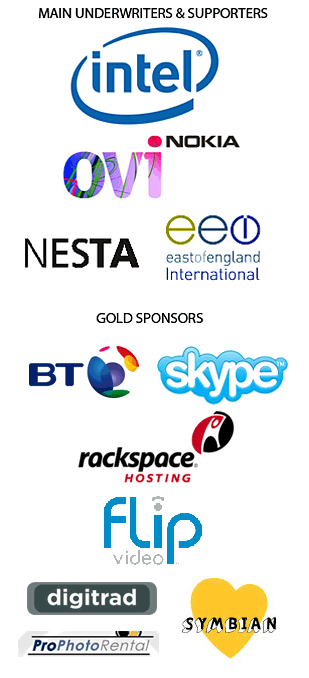Toward the era of (printed?) sentient things…
by Howard Rheingold on July 22, 2009 at 9:06 pm
When I wrote Smart Mobs in 2001 and launched the smartmobs.com blog with the book in 2002, I made a number of forecasts about the convergence of the mobile phone, the personal computer, and the Internet. Some of these forecasts, particularly in regard to the use of mobile communications to organize political demonstrations, were accurate. Some of them haven’t happened yet. Some of them might not happen at all. I looked back at Smartmobs Revisited when I spoke at Mobile Monday Amsterdam in June, 2009. And I recently blogged about some reasons why the mobile Web hasn’t developed as rapidly as the tethered web did. Another 2001-2 forecast that has not come to pass by 2009 was what I called “the era of sentient things:”
Different lines of research and development that have progressed slowly for decades are accelerating now because sufficient computation and communication capabilities recently became affordable. These projects originated in different fields but are converging on the same boundary between artificial and natural worlds. The vectors of this research include:
* Information in places: media linked to location.
* Smart rooms: environments that sense inhabitants and respond to them.
* Digital cities: adding information capabilities to urban places.
* Sentient objects: adding information and communication to physical objects.
* Tangible bits: manipulating the virtual world by manipulating physical objects.
* Wearable computers: sensing, computing, communicating gear worn as clothing.Information and communication technologies are invading the physical world, a trend that hasn’t even begun to climb the hockey stick growth curve. Shards of sentient silicon will be inside boxtops and dashboards, pens, street corners, bus stops, money, most things that are manufactured or built, within the next ten years. These technologies are “sentient” not because embedded chips can reason, but because they can sense, receive, store, and transmit information. Some of these cheap chips sense where they are: the cost of a global positioning system chip capable of tracking its location via satellite to accuracy of ten to fifteen meters is around $15 and dropping.
Watch smart mobs emerge when millions of people use location-aware mobile communication devices in computation-pervaded environments. Things we hold in our hands are already speaking to things in the world. Using our telephones as remote controls is only the beginning. At the same time that the environment is growing more sentient, the device in your hand is evolving from portable to wearable. A new media sphere is emerging from this process, one that could become at least as influential, lucrative, and ubiquitous as previous media spheres opened by print, telegraphy, telephony, radio, television, and the wired Internet.
But…not yet. However, I’ve seen a couple of recent indicators that this forecast might have been more premature than totally off the mark. First, one of the most reliable early indicators I turn to all the time, one of the few RSS feeds that I rarely miss scanning at least once a day, ReadWriteWeb, recently noted that IBM might be getting into the act:
In the Web world, you know that a trend has major traction when IBM is all over it. Like any large Internet company, Big Blue is careful about which trends it latches onto. It was a good couple of years before they were spotted at the Web 2.0 conference, for example. However in the case of Internet of Things, IBM is proving itself to be an unusually early adopter.
I recently spoke to Andy Stanford-Clark, a Master Inventor and Distinguished Engineer at IBM. Yesterday we wrote about how Stanford-Clark has hooked his house up to Twitter. Today we delve more into what his employer, IBM, is doing with the Internet of Things.
IBM is involved in some very interesting projects at the intersection of two big trends we’ve been tracking in 2009: The Real-time Web and Internet of Things. They have a website devoted to this topic, called A Smarter Planet. As the name implies, it focuses on environmental matters such as energy and food systems. Sensors, RFID tags and real-time messaging software are major parts of IBM’s smarter planet strategy. The catchcry for the site – Instrumented, Interconnected, and Intelligent – is about outfitting the world with sensors and hooking them to the Internet to apply the ’smarts.’
My spider-sense might not have tingled as strongly at this tidbit about IBM if I had not met Dr. Kate Stone in Cambridge, UK, a few weeks ago. Although the Travelling Geeks had seen dozens of remarkable startups in London and in Cambridge, the hint of what-might-be-news came when Dr. Stone approached me after a series of pitches and told me about Novalia, a company that is combining current printing techniques, electroconductive ink, and ultra-thin control units to make paper an interactive medium, capable of sensing visual, auditory, or touch inputs, connecting to the Web, displaying audiovisual information. At least in theory. I didn’t see any prototypes. But if you put together the clues from Novalia’s website with the more concrete news from IBM, it seems like the era of sentient things might still be ahead of us – and maybe not too far:
Control module
We have developed and supply a ‘printed electronics control module’; this self contained unit consists of a power source, integrated circuit (I/O control and interaction flow), and sound transducer.Integration
The module is very simple to integrate with the printed item, in fact it’s almost as easy as putting a stamp on an envelope (but for now it’s not quite as thin).Senses
The integration of the module and the conductive inks enables the printed item and the user to communicate through the senses of touch, sightand sound.


